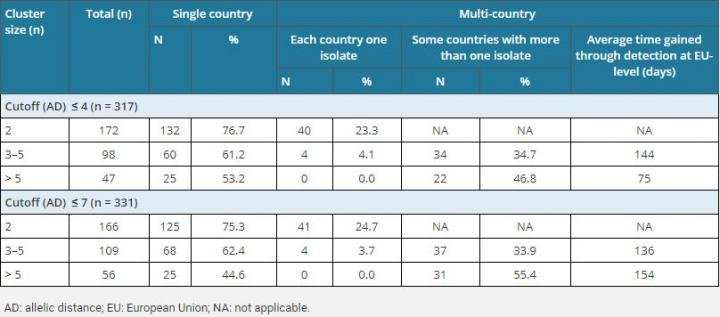Listeria surveillance: New EU-wide study reveals that most outbreaks remain undetected

More than half of the severe listeriosis cases in the European Union belong to clusters, many of which are not being picked up fast enough by the current surveillance system, suggests a new article published in Eurosurveillance. The large-scale study looked into listeriosis epidemiology through whole genome sequencing and found that this method, when implemented at EU-level, could lead to faster detection of multi-country outbreaks, saving up to 5 months of the investigations.
The study, coordinated by the European Centre for Disease Prevention and Control (ECDC), analysed 2 726 human Listeria monocytogenes isolates from 27 countries between 2010 and 2015.
It found that slightly under 50% of the cases are isolated whereas the remaining half of cases is clustered together. Around one third of the cases that were identified as part of a cluster affected more than one country, often lasting for several years. However, only two listeriosis outbreaks were reported in the EU in 2016 and five in 2015, which suggests that many of them have gone undetected.
The authors determined that the use of whole genome sequencing to characterise listeriosis cases at EU-level could speed up the detection of clusters by up to five months, when compared to epidemiological investigation at country level. A more timely detection of clusters would potentially limit the occurrence of further cases from the same, common food source.
"This study is a milestone on the way to tackling listeriosis in Europe. With this new collaborative effort with the Member States, we have revealed the related nature of many cases of severe listeriosis. We are now strengthening routine surveillance by introducing the collection and analysis of whole genome sequencing data from all reported human listeriosis cases", says ECDC's Chief Scientist Mike Catchpole.
Listeriosis is a relatively rare but potentially severe food-borne disease that has been reported in increasing numbers in the EU/EEA countries since 2008. In 2016, 2 536 cases were reported, including 247 deaths. "Improving our surveillance on Listeria cases will save lives, particularly among vulnerable population groups such as the elderly and also pregnant women, who may pass on the bacteria to the fetus if they consume contaminated food", Mike Catchpole points out.
The study also defines the most appropriate typing methods for earlier detection and investigation of dispersed cross-border clusters and outbreaks of Listeria monocytogenes.
More information: Ivo Van Walle et al, Retrospective validation of whole genome sequencing-enhanced surveillance of listeriosis in Europe, 2010 to 2015, Eurosurveillance (2018). DOI: 10.2807/1560-7917.ES.2018.23.33.1700798

















